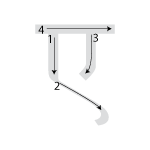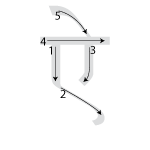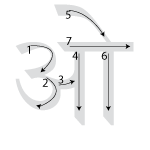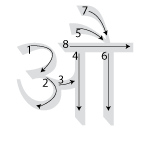 |
Introduction Lesson5 Lesson6 Lesson7 |
|
|||
|
Lesson 6 1 The Letters
1.1 The Vowels
1.2 Pronunciation 1.2.1 The pronunciation of <ए> and <ओ> The pronunciation of the vowels <ए> and <ओ> are akin to the vowels of English - <e> and <o> as in <gate> and <goal> respectively. However there is a difference. The Hindi sounds are ‘pure’ vowels whereas the English sounds are diphthongs. The English vowels are followed by semi vowels written as /ei/ and /ou/respectively. Listen to the pronunciation of the words. Hindi /ge:T/ 1.2.2. The pronunciation of <ऐ> and <औ> The pronunciation of the vowels <ऐ> and <औ> has been shown as <ai> and <au> respectively as there is no agreed symbol available in English alphabet. The notation could give us the impression that these are diphthongs. The fact is that these two are pure vowels in Hindi represented by the phonetic notation / ε/ and / ɔ/ respectively. Listen to the words – ऐब 1.2.3. The letter <ऋ> The letter <ऋ> is placed in the alphabet with other vowels. It behaves like a vowel as it has a matra but it more a syllable than a vowel as it consists of a consonant too. Its phonetic notation is /rɨ/. Listen to the words – ऋण 1.3 The matras of these vowels 1.3.1 The matra of <ए> and < ऐ> The matra of <ए> and < ऐ> are placed above the letter. See the difference between the vowels and the syllables in the number of strokes above. ए – के ऐ – कै1.3.2. The matra of <ओ> and < औ> The vowels <ओ> and < औ> are formed from the vowel <अ> and the syllables <को> and <कौ> are formed similarly from the consonant <क> in the same way. ओ – को औ – कौ1.3.3. The matra of < ऋ >The matra of < ऋ > is ृ which is placed beneath the letter- <कृ>. 2 Reading Practice
|
|||||||||||||||||||||||||||||||||||||||||||||||||||||||||||||||||||||||||||||||||||||||||||||||||||||||||||||||||||||||||||||||||||||||||||||||||||||||||||||||||||||||||||||||||||||||||||||||||||||||||||||||||||||||||||||||||||||||||||||||||||||||||||||||||||||||||||||||||||||||||||||||||||||||||||||||||||||||||||||||||||||||||||||||||||||||||||||||||||||||||||||||||||||||||||||||||||||||||||||||||||||||||||||||||||||||||||||||||||||||||||||||||||||||||||||||||||||||||||||||||||||||||||||||||||||||||||||||||||||||||||||||||||||||||||||||||||||||||||||||||||||||||||||||||||||||||||||||||||||||||||||||||||||||||||||||||||||||||||||||||||||||||||||||||||||
एक |
एकता |
एड़ी |
केला |
मेला |
देरी |
मेरा |
सवेरा |
one |
unity |
heel |
banana |
fair |
delay |
my |
morning |
सुरेश |
रमेश |
राजेश |
लड़के |
कपड़े |
पंखे |
सवेरे |
पहले |
Suresh |
Ramesh |
Rajesh |
boys |
clothes |
fans |
In the morning |
firstly |
Words with <ऐ>
ऐनक |
ऐश |
ऐब |
पैर |
सैर |
पैदल |
तैरना |
बैठना |
glasses |
indulgence |
folly |
leg |
tour |
On foot |
To swim |
To sit |
मैना |
कैसे |
पैसा |
मैला |
कुवैत |
बगैर |
कसैला |
वगैरह |
mynah |
how |
paisa |
soiled |
Kuwait |
without |
… |
Et cetera |
Words with <ओ>
ओर |
ओस |
ओला |
ओछा |
दो |
कोना |
सोना |
शोर |
direction |
dew |
hail |
mean |
two |
corner |
gold |
noise |
लोग |
मोर |
चोर |
टोकरी |
छोटा |
रखो |
उठो |
बैठो |
people |
peacock |
thief |
basket |
small |
Keep it. |
Get up. |
Sit. |
In the case of roots ending in consonants the imperative verbs for friends or youngsters are formed by adding /o/ which is represented by the matra of <>.
Listen to the pronunciation of the words, repeat and practice. Read the verb as an imperative.निकलो |
पूछो |
सीखो |
उठो |
नाचो |
माँगो |
रुको |
ठहरो |
Leave. |
Ask. |
Learn. |
Get up. |
Dance. |
Demand. |
Stop. |
Stay. |
Words with <औ>
और |
औरत |
शौक |
लौटना |
दौड़ना |
नौका |
मौका |
चौदह |
and |
woman |
hobby |
To come back |
To run |
boat |
chance |
fourteen |
Words with <ऋ> /ri/
ऋण |
ऋतु |
कृपा |
कृपया |
गृह |
दृग |
हृदय |
शृंगार |
loan |
season |
kindness |
please |
home |
eyes |
heart |
make up |
2.4 Feminine plural nouns
We have discussed that word final nasalization is represented by a dot if the matra comeson top of the letter. The same thing applies to the word में ![]() ‘in’.
‘in’.
Feminine plural nouns ending in vowels other than /i:/ are formed by adding /ẽ/. The nasalized vowel <एँ> is added to the word if it ends in a vowel (other than /i/), such as माला ![]() मालाएँ
मालाएँ ![]() ‘garlands’. It is represented by the matra and a dot in the case of feminine plural nouns ending in a consonant such as रात
‘garlands’. It is represented by the matra and a dot in the case of feminine plural nouns ending in a consonant such as रात ![]() रातें
रातें ![]() ‘nights’.
‘nights’.
माताएँ |
बहनें |
दुकानें |
दीवारें |
आँखें |
किताबें |
शामें |
सड़कें |
mothers |
sisters |
shops |
walls |
eyes |
books |
evenings |
roads |
2.4.1 Plural Subjunctive verbs
Plural subjunctive verbs such as करें ![]() (We may do/ Let us do) and करें?
(We may do/ Let us do) and करें? ![]() (Shall we do?) are formed by adding /ẽ/ to the root. If the root ends in a vowel <> is added to it, if the root ends in a consonant it takes a matra and a dot.
(Shall we do?) are formed by adding /ẽ/ to the root. If the root ends in a vowel <> is added to it, if the root ends in a consonant it takes a matra and a dot.
आएँ |
जाएँ? |
बनाएँ |
लाएँ? |
खाएँ? |
सिखाएँ |
पिएँ (पीना) |
सोएँ? |
come |
go |
prepare |
bring |
eat |
teach |
drink |
sleep |
निकलें? |
पूछें |
सीखें |
उठें? |
नाचें |
माँगें? |
रुकें |
ठहरें |
leave |
ask |
learn |
Get up |
dance |
demand |
stop |
stay |
3.1 Recognition
3.1.1 Letter Recognition
Press the letter pronounced. Once you finish you can start the list all over.
Press the syllable pronounced. Once you finish you can start the list all over.
थे |
हो |
मैं |
सौ |
कृ |
3.1.2 Sound Recognition - First Letter
Listen to a word, recognize the first sound of the word and punch it. You can see the word just for two seconds. However you can listen to it many times.| एड़ी | ||||
Next |
Exit |
3.1.3 Recognition of the vowel in a syllable
Recognize the vowel in the first syllable of the word occurring as a matra and punch the vowel. You can see the word just for two seconds. However you can listen to it many times.केला |
पौधा |
मौन |
केंद्र |
चौंकना |
शोरबा |
ठोकर |
थैली |
ए |
औ |
औ |
ए |
औ |
ओ |
ओ |
ऐ |
3.1.4 Sound Recognition - Last Letter
Now listen to the last letter of the word, recognize the sound and punch it.| जूते | ||||
Next |
Exit |
3.2 Matching
Listen to the pairs of words. If both words pronounced are similar press ‘same’; if not press ‘different’.| Same | Different | ||
Next |
Exit |
4.1 Spelling and Pronunciation
If the two vowels <ए> and <ओ> occur within a word after a long vowel or at the end of the word the pronunciation of these vowels /ए/ and /ओ/ tend to be shorter in comparison with the corresponding vowels of <ये> and <यो>. Listen – के लिए ![]() (for) लिये
(for) लिये ![]() (bought); जाओ
(bought); जाओ ![]() (go) योयो
(go) योयो ![]() (yoyo). So this does not apply to words such as पिएगा
(yoyo). So this does not apply to words such as पिएगा ![]() (he will drink) पिएँगे
(he will drink) पिएँगे ![]() (they will drink) पिओ (drink)
(they will drink) पिओ (drink) ![]() पिओगी?
पिओगी? ![]() (will you drink) हुए
(will you drink) हुए ![]() (happened) छुए
(happened) छुए ![]() (touched) छुओगे (if you touch)..
(touched) छुओगे (if you touch)..
4.1.2 Imperative verbs for elders or in formal situations
We use a different imperative form for elders or formal acquaintances as mark of respect. The form <> is added to the roots – the same form is added to vowels such as (please come) or matra of<> if added to a consonant such as (Please speak). In either case the final <> is pronounced short.
Listen to the pronunciation of the words, repeat and practice. We give only the meaning of the root with the words.निकलिए |
पूछिए |
सीखिए |
उठिए |
नाचिए |
माँगिए |
रुकिए |
ठहरिए |
Leave. |
Ask. |
Learn. |
Get up. |
Dance. |
Demand. |
Stop. |
Stay. |
4.1.3 Alternate pronunciation of <ऐ> and <औ>
If <ऐ> is followed by <य> it is pronounced as /ay/; if <औ> is followed by <व> then it is pronounced as /av/. You may also note the word शय्या has already this sound /shayya/ though it is not written with <ऐ>; similarly अव्वल pronounced as /avval/ is not written with <औ>.
4.1.4 English /ai/
English has a vowel which is closer to the Hindi vowel <ऐ> but distinctly more open. Hindi represents this vowel in borrowed words with the matra of <> itself. So we have no way on knowing the distinction by the spelling. The different vowel can only be accessed by knowing the origin of the word.
Listen to the pronunciation of the words, repeat and practice.
गैस |
बैलेंस |
पैड |
गैलन |
बैंक |
टैंक |
हैंडबैग |
सैंडविच |
gas |
balance |
pad |
gallon |
bank |
tank |
handbag |
sandwich |
4.1.5 The vowels <ए> and <ओ> before <ह>
We saw in Lesson 4 that <अ> before <ह> undergoes phonetic change. Similarly vowels <ए> and <ओ> before <ह>undergo sound change. Monosyllabic words such as देह ![]() ‘body’ do not undergo this change.
‘body’ do not undergo this change.
मेहमान |
मेहनती |
बेहतर |
तेहरान |
मेहरा |
देहाती |
सेहत |
रेहन |
guest |
studious |
better |
Tehran |
Mehra |
rural |
health |
pawn broking |
You may also note that both <ए> and <अ> before <ह> sound alike in this context. That is the reason some words have dual spelling though the pronunciation is the same such as मेहरी/ महरी ![]() ‘maid’, एहसास/ अहसास
‘maid’, एहसास/ अहसास ![]() ‘feeling’.
‘feeling’.
Let us see words where <ओ> before <ह> undergoes sound change. Monosyllabic words such as मोह ![]() ‘passion’ do not undergo this change.
‘passion’ do not undergo this change.
बोहनी |
कोहनी |
शोहदा |
शोहरत |
ओहदा |
सोहबत |
मोहसिन |
मोहर |
first sale of the day |
elbow |
ruffian |
fame |
status |
company |
Mohsin |
seal |
You may also note that since is pronounced short like // we come across a few words with dual spelling but same pronunciation such as कुहनी/ कोहनी![]() ‘elbow’, कुहरा/ कोहरा
‘elbow’, कुहरा/ कोहरा ![]() ‘fog’,मुहम्मद/ मोहम्मद
‘fog’,मुहम्मद/ मोहम्मद ![]() Mohammed.
Mohammed.
For detailed information on spelling you should consult a book on grammar.
4.1.6 Short /e/ and /o/ of some words
Hindi does not have a letter for short /e/ in words such as ‘pen’. Some Indian languages have the short /e/ and/short /o/ as well. As a consequence two words with the same spelling have different pronunciation such as सेल H1374 ‘cell’ and सेल H1375 ‘sale’. However Hindi speakers manage to pronounce the short vowels from their knowledge of the original word.
Listen to the pronunciation of the words, repeat and practice.4.2 Perception of Expressions
Click icon to listen to a phrase/sentence and say which one of the five is pronounced by pressing it.
4.2.1 Pattern 1
मेरे पिता जी कानपुर गये हैं. ![]() My father has gone to Kanpur.
My father has gone to Kanpur.
4.2.2 Pattern 2 -Phrases
पाकिस्तान एशिया में है. ![]() Pakistan is in Asia.
Pakistan is in Asia.
4.3 Reading Expressions
Read the following expressions. You may listen to the pronunciation of the sentences when necessary. Practice till you are able to read fluently.
5.1 Letter Formation
See how the letters are written. You will learn to write them in your PDF. Go to 5.2
 |
 |
 |
 |
 |
5.2 Copying
5.2.1 Copy the lettersPrint the page and copy the words you hear. If you need to do the Writing Practice again exit the program and print another PDF

5.2.2 Copying words
Try to get the pronunciation as you write. You can listen to the word many times. When ready to write you can see the word many times by pressing the Show Hint button.
You should get a mental image of the whole word and write it from memory. Do not copy letter by letter.
Next |
Back |
|
5.3 Word formation
Listen to the pronunciation of the word, press the appropriate letters to form that word. You can listen to or see the word many times.
5.4 Dictation
Listen to the words and write in the page. You can listen to or see the word many times.
After writing your word press Show Hint once more for reinforcement.
| आइए | |||
Next |
Exit |
||
6.1 Write sentences: Imperative
Write two imperative sentences using the phrases given for both ‘tum’ (youngsters0 and a:p (elders) as per the model given.
वह साड़ी निकालना |
तुम वह साड़ी निकालो. |
आप वह साड़ी निकालिए. |
एक गिलास पानी लाना |
......................................................... | ......................................................... |
हिंदी में बोलना |
......................................................... | ......................................................... |
पाँच मिनट रुकना |
......................................................... | ......................................................... |
दुकान पर जाना |
......................................................... | ......................................................... |
यह पाठ टाइप करना |
......................................................... | ......................................................... |
एक बजे वापस आना |
......................................................... | ......................................................... |
माँ से यह बात कहना |
......................................................... | ......................................................... |
कल शाम को आना |
......................................................... | ......................................................... |
| Next Lesson |